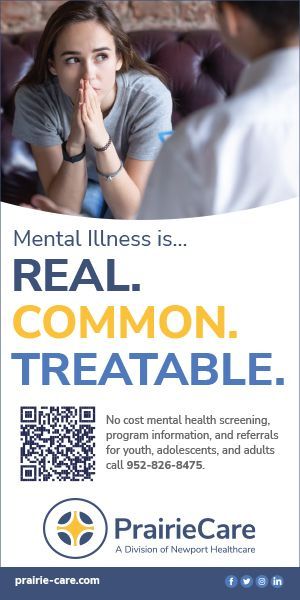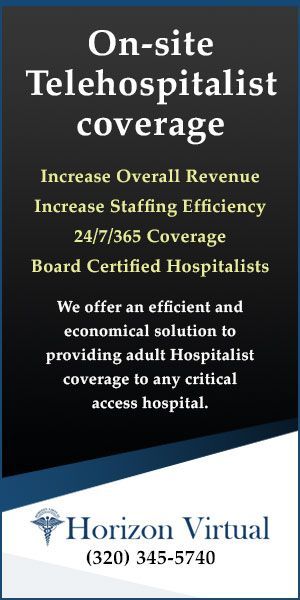hen a patient presents with a mental health issue, the physician’s biggest challenge can be connecting the patient to the help needed. The patient may seem engaged and thankful for the referral, but this enthusiasm can vanish quickly. The patient may never make an appointment, or may make an appointment and become a no-show. For patients living in greater Minnesota, lack of mental health provider options and greater travel times can exacerbate these concerns.
Rural Health
Improving Rural Mental Health Care
Upstream and Downstream Solutions
BY David Beard, PhD, Zomi Bloom, MBA, and Chance Lasher
There are many reasons why patients find it hard to seek mental health care. Some feel a sense of stigma, some feel safe discussing these issues with a trusted physician but are anxious talking about them with a stranger. Once patients are connected with support, weekly or biweekly therapist appointments, combined with monthly medication management visits, can become burdensome and lead to poor compliance. This could have impacts on quality scores for providers who are subject to Minnesota Community Measurement performance with PHQ-9 screening, follow-up and remission scores.
To support their patients, physicians and their care teams can utilize both upstream and downstream resources to best serve their patients’ mental health needs.
The River of Mental Health Care
An old story helps explain the challenges of providing mental health care. According to the story, a man sees a person caught in a river. He leaps to the rescue, pulling the cold, wet, shaking body to shore for CPR. As he looks up, he sees someone else in the river in need of saving. He dives back in, successfully returning to shore, exhausted. He looks up again to see even more people flailing in the water.
He goes upstream searching for the reason why people are falling into the river. He finds that there is a bridge without a railing and replaces the railing, keeping people from falling in.
Mental health, we learn from this story, must include both upstream and downstream approaches to care. An upstream approach to health benefits everyone, in that it stops so many people from falling in the river. While upstream, people are able to get support before a crisis occurs. In the downstream approach to health care, individuals are in need of specific and individual treatment for a crisis. Downstream interventions are essential but expensive; effective use of upstream interventions can save money and save lives.
Improving Rural Mental Health Care.
Upstream Resources
Upstream mental health resources can help improve or stabilize a person’s mental health before a crisis occurs and can include everything from spiritual congregations to exercise facilities. These resources bring community, joy and balance to people’s lives. They can help improve or stabilize a person’s mental health before a crisis occurs.
Hiking clubs are both an upstream mental health resource (in that they encourage the social and physical behaviors that create mental wellness) and an upstream physical health resource. A patient experiencing diabetes is more likely to experience depression and anxiety – effects of living with a chronic illness. Anxiety and depression can become factors that prevent healthy behaviors, like daily walks and managing meals, which are necessary for long-term health. A hiking club is an upstream resource for managing these challenges.
Downstream Resources
Downstream mental health resources provide support and treatment to people experiencing a mental health crisis. These can include treatment centers for mental and substance-use disorders, crisis phone lines and clinics and hospitals that work with people in crisis.
Downstream resources are the ones a physician probably thinks of most often when caring for a patient with a mental health condition. Unfortunately, across Minnesota the wait time for access to a therapist or psychiatrist can be months. To be seen quickly, a patient oftentimes must present in a crisis. A trip to the emergency room is both expensive and uncomfortable for the patient.
Understanding Limited Access
Wilderness Health, a collaborative of health care systems in northeastern Minnesota, recently used the software ARCGIS to map the geographic location of mental health services in Carlton County. The results were concerning. The only places to receive in-person care in Carlton County are in or near Cloquet and Moose Lake.
This underscores the increasing importance of telehealth in meeting the needs of rural residents. Rural areas face challenges when it comes to time off work, impact of weather (think driving through snow on rural county roads) and travel time to appointments.
This phenomenon – of services being concentrated in more densely populated towns within a rural county – is not unique to Carlton County. Most counties in Minnesota are in federally designated mental health shortage areas, as defined by the Health Resources and Services Administration (HRSA). All of the Minnesota counties in the Wilderness Health member hospital service area – Carlton, St. Louis, Itasca, Lake and Cook – are designated as mental health shortage areas.
Through the Rural Health Network Development (RHND), the telehealth committee within Wilderness Health is piloting several telehealth programs. First, Wilderness Health developed a telehealth toolkit containing supportive materials, resource guides and marketing templates to support patients and care teams alike.
Second, Wilderness Health is piloting an ambulatory integrated behavioral health rapid therapy and assessment program. We partnered with Behavioral Health Innovation, a boutique service development and deployment firm for the mental and behavioral health field, focusing on telehealth solutions. The partnership allows primary care providers to refer patients through an online platform connecting them with a therapist or psychologist. From there, the evaluating mental health provider can help distinguish what mental health conditions are present and send a report back to the PCP so they can start medication treatment if indicated. Patients can also get access to rapid therapy or continuing therapy.
Third, Wilderness Health partnered with Kari Rengo, DNP, APRN, PMHNP-BC, to offer psychiatric curbside consultations in a video call format. Rengo, a psychiatric nurse practitioner who maintains a telehealth-only practice, hosts drop-in sessions to allow Wilderness Health member practitioners to ask questions about managing their patients’ mental health needs. These needs range from psychosocial supports to details about medications prescribed.
It is important to connect mental health providers across the region with primary care providers and care teams for conversation and collaboration. Due to the shortage of mental health providers – greatest in rural areas – it is all hands on deck to care for the needs of patients in our communities.
Dr. Gretchen Karstens, a pediatrician with St. Luke’s Pediatrics and medical director for Wilderness Health, has utilized curbside consultations and referrals to rapid telemental health therapy. She notes, “Missing work or pulling our kids from school for the drive to and from distant appointments is an additional burden to accessing health care for many patients in our region. When our communities have better access to care, everyone benefits.” She has utilized curbside consults to talk through challenging cases and expand her expertise in navigating complex psychiatric medication choices. She has also found that improved communication with skilled mental health professionals improves the care she offers to her patients.
Upstream and Downstream Solutions.
Wilderness Health supports providers by inviting mental health professionals across the region to present to our telehealth committee and share their practice, their specialties and strengths, and how they are using telehealth to improve access to care. These initiatives are part of our project to advance access to health care in rural Minnesota.
Innovative Practices Statewide
While there are unique challenges to rural mental health care, there are statewide resources that can help providers in rural and urban Minnesota alike. The Mental Health Collaboration Hub (MHCH) is one such resource. More than 150 organizations and over 350 individual users, including nurses, case managers, administrators and more, collaborate daily in the MHCH, which exists to connect young people with complex mental health issues to appropriate inpatient care.
When using the MHCH, hospital staff enter de-identified case information, including a patient’s age, psychiatric condition, special medical needs, guardianship and insurance coverage. According to Todd Archbold, one of the architects of the hub and CEO of PrairieCare, “Youth who are boarding actually represent a very small percentage of cases who present to hospital and emergency departments, but they require the most resources—including specialized interventions and robust ancillary services. The MHCH does all of this for the case worker, functioning as a care pathways marketplace.” The MHCH is typically accessed by a social worker or case manager and is an important tool for physicians attempting to connect a patient with resources.
The Psychiatric Assistance Line (PAL) is a free service available to health professionals Monday through Friday from 8 a.m.-6 p.m. Any provider can call for mental health triage and referral, or for a consultation with a board certified child and adolescent psychiatrist regarding a patient. It is a free service provided by PrairieCare through a grant from the Minnesota Department of Human Services. Resources and treatment protocols are also available. This service helps bridge the gap between primary care and specialty psychiatric care across the state.
Fast-Tracker Minnesota is another statewide tool aimed at improving and streamlining access to mental health care. It features a search engine that allows providers and care teams to search for psychiatric options in their area. It includes recovery and support group information and works to improve communication between primary and specialty care providers.
Next Steps for Physicians
By focusing on “upstream” and “downstream” resources, and by complementing local resources with telehealth resources (including PAL, FastTracker, and MHCH), physicians can enrich their ability to offer the best care possible to their patients. Keeping this panoply of tools at the ready can make mental and behavioral health available and affordable for patients.
Upstream resources in many cases are openly enjoyed within a community. Joining a hiking club can be entirely free (and encourage social and physical well-being). Downstream resources, accessed in a crisis, can be very expensive, but tools like telehealth and like the MHCH can help a provider connect patients to resources that are both available and affordable.
Physicians should be aware of resources that offer their patients both upstream and downstream supports. From the upstream (prevention) perspective, these may include community centers to bring people together for wellness activities and social connection. From the downstream (treating illness) perspective, these may include community mental health and substance-abuse intervention services.
Social and spiritual support systems can prevent mental health challenges and can assist patients who experience significant mental health challenges. Physicians can better serve their patients by becoming aware of preventive resources in the community. Physicians should also be aware of behavioral health therapy and crisis support services so they can connect their patients with the right level of care. They can be champions for their patients in supporting their overall well-being.
To access the full spectrum of community services to support mental health, physicians can prepare their patients to access telehealth. Telehealth can reduce no-shows to therapy or medication management visits. Physicians and psychiatric providers can utilize telehealth visits to check in on patients after prescribing a new medication, such as an antidepressant. Mental health and substance-use therapists can utilize telehealth visits to perform cognitive behavioral therapy, trauma therapy or other modalities to support patients with behavioral health needs.
Telehealth’s incorporation into physician practice can enhance existing services. For example, a physician can suggest that a patient conduct medication follow-up via video call. This can reduce the patient’s travel time and make it easier to keep the appointment. When making a referral to a mental health provider, a physician can explain that the patient may be able to conveniently access visits through telehealth.
And finally, behind the curtain, a provider can collaborate with others to use tools like the MHCH, PAL and Fast-Tracker Minnesota to connect with professionals across the state to best serve their patients. In rural northeastern Minnesota, consider connecting with the telehealth committee created by Wilderness Health.
By accessing the wider array of upstream and downstream resources and by accessing the wider array of therapeutic and psychiatric treatments, physicians can improve care for their patients. These small changes in practice can improve patient compliance and improve patient wellness.
David Beard, PhD, is interim director of graduate studies in the Master of Professional Studies program at the University of Minnesota Duluth.
Zomi Bloom, MBA, and Chance Lasher are on the administrative staff of Wilderness Health https://wildernesshealthmn.org.
MORE STORIES IN THIS ISSUE
cover story one
A Crisis in Home Health Direct Care: The Minnesota Solutions Model
By Jesse Bethke Gomez, MMA
cover story two
The MN 2035 Plan: Improving Public Health
By Thomas E. Kottke, MD, and Clarence Jones





















